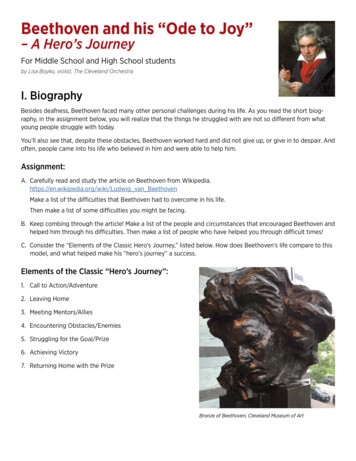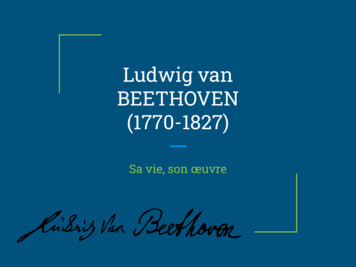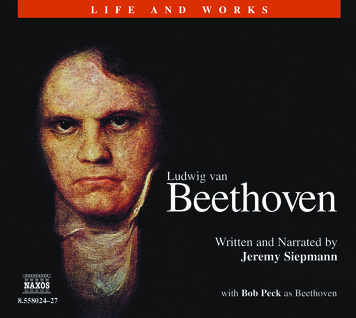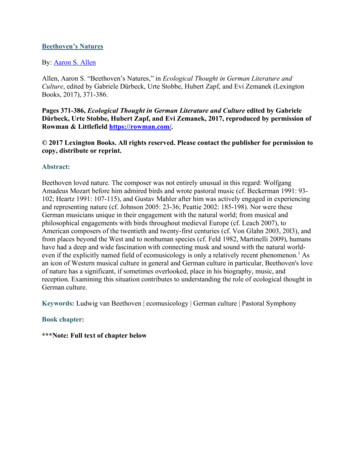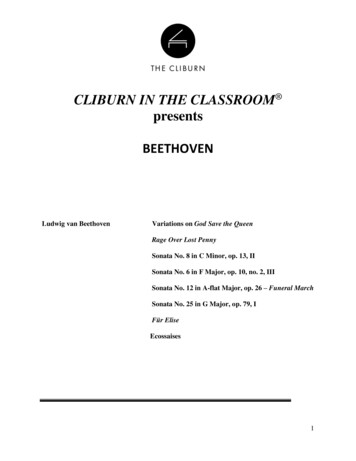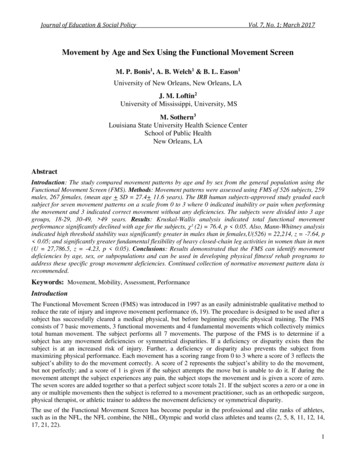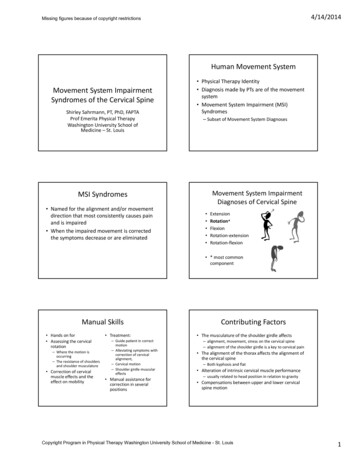
Transcription
FIRST MOVEMENT OF THE BEETHOVEN THIRD PIANO CONCERTO: ANARGUMENT FOR THE ALKAN CADENZAYang Ding, B.M., M.M.Dissertation Prepared for the Degree ofDOCTOR OF MUSICAL ARTSUNIVERSITY OF NORTH TEXASMay 2015APPROVED:Pamela Mia Paul, Major ProfessorClay Couturiaux, Committee MemberAdam Wodnicki, Committee MemberSteven Harlos, Chair of the Department ofKeyboard StudiesBenjamin Brand, Director of Graduate Studiesin MusicJames C Scott, Dean of the College of MusicCostas Tsatsoulis, Interim Dean of theToulouse Graduate School
Ding, Yang. First Movement of the Beethoven Third Piano Concerto: An Argument for theAlkan Cadenza. Doctor of Musical Arts (Performance), May 2015, 33 pp., 12 musical examples,bibliography, 41 titles.The goal of this dissertation is not only to introduce the unique cadenza by Alkan but alsoto offer an argument from the performer’s point of view, for why Alkan’s cadenza should beconsidered when there exists a cadenza by Beethoven himself, not to mention those by a numberof other composers, both contemporaries of Beethoven and later. Information in reference to thebrief history of the cadenza and the pianoforte in the time of Mozart and Beethoven is presentedin Chapter 2. A brief bibliography about Alkan is presented in Chapter 3. Chapter 4 describes notonly the cadenza in the era of Alkan, but also a comparison which is presented betweenBeethoven and Alkan's cadenzas. Examples of the keyboard range, dynamic contrast, use ofpedal and alternating notes or octaves, and creative quote are presented in Chapter 4. Inconclusion, the revival of Alkan's cadenza is mentioned, and the author's hope to promote theAlkan's cadenza is presented in Chapter 5.
Copyright 2015byYang Dingii
ACKNOWLEDGEMENTSI would like to give my deepest appreciation to my beloved professor, Dr. Pamela MiaPaul, for her selfless dedication to my piano study in the past several years, and for herinvaluable assistance in the entire dissertation process.Grateful acknowledgment is also expressed to Dr. Clay Couturiaux and Prof. AdamWodnicki, the other members of the doctoral committee, for their valuable suggestions andcomments.Deepest appreciation to Jim and Shirley Slutz for the editorial assistance and advice asproofreaders. Appreciation to my friend Tate C. Addis, a great pianist and organist, for providingme with a clear version of Alkan's Cadenza to Beethoven’s Piano Concerto No. 3, 1st movement,which is the origin of this dissertation. Special thanks must be given to Imre Pátkai for his helpand advice in formatting this document.Finally, I would like to thank my parents for their continuing support during my eightyears of study in the United States.iii
TABLE OF CONTENTSPageACKNOWLEDGEMENTS . iiiLIST OF MUSICAL EXAMPLES .vCHAPTER 1 INTRODUCTION .1Purpose.1CHAPTER 2 BRIEF HISTORY OF THE CADENZA AND THE PIANOFORTE IN THETIME OF MOZART AND BEETHOVEN .2The Cadenza in the Time of Mozart .2The Cadenza in the Time of Beethoven and the Influence of the Developing Fortepianoon his Virtuosic Writing.5CHAPTER 3 CHARLES-VALENTIN MORHANGE ALKAN - A BRIEF BIOGRAPHY.11CHAPTER 4 CADENZA IN THE ERA OF ALKAN AND A COMPARISON OF THEBEETHOVEN CADENZA AND THE ALKAN CADENZA .16CHAPTER 5 CONCLUSION.25BIBLIOGRAPHY .30iv
LIST OF MUSICAL EXAMPLESPageExample 1.Beethoven's Cadenza to his Piano Concerto No. 3 in C minor, Op. 37, 1stmovement, measure 16 .6Example 2.Mozart's Cadenza to his Piano Concerto No. 17 in G Major, K.453, 1stmovement, measures 32-34 .7Example 3.Beethoven's Cadenza to his Piano Concerto No. 3 in C minor, Op. 37, 1stmovement, measure 17 .8Example 4.Beethoven's Cadenza to his Piano Concerto No. 3 in C minor, Op. 37, 1stmovement, measures 53-64 .8Example 5.Alkan Cadenza to Beethoven Piano Concerto No. 3 in C minor, Op. 37, 1stmovement, measures 48-56 .18Example 6.Alkan Cadenza to Beethoven Piano Concerto No. 3 in C minor, Op. 37, 1stmovement, measures 128-129 .18Example 7.Alkan Cadenza to Beethoven Piano Concerto No. 3 in C minor, Op. 37, 1stmovement, measures 147-162 .19Example 8.Alkan Cadenza to Beethoven Piano Concerto No. 3 in C minor, Op. 37, 1stmovement, measures 130-133 .21Example 9.Alkan Cadenza to Beethoven Piano Concerto No. 3 in C minor, Op. 37, 1stmovement, measures 117-121 .22Example 10. Alkan Cadenza to Beethoven Piano Concerto No. 3 in C minor, Op. 37, 1stmovement, measures 71-76 .23Example 11. Alkan Cadenza to Beethoven Piano Concerto No. 3 in C minor, Op. 37, 1stmovement, measures 81-82 .23Example 12. Alkan Cadenza to Beethoven Piano Concerto No. 3 in C minor, Op. 37, 1stmovement, measures 89-90 .24v
CHAPTER 1INTRODUCTIONPurposeCharles-Valentin Alkan, a contemporary and friend of Liszt and Chopin, was a leadingFrench composer and pianist whose music was neglected during his lifetime, although lateradvocated by such modern pianists as Ferruccio Busoni, Harold Bauer, Carl Friedberg, RaymondLewenthal, Egon Petri, Ronald Smith, Claudio Arrau and Marc-AndréHamelin. Among Alkan'slesser-known contributions to the piano literature is his cadenza to the first movement ofBeethoven’s Third Piano Concerto. Alkan's cadenza is unusual in that it consists of 197 measures.The duration of the cadenza is about 8 minutes while the first movement itself lasts only about10-13 minutes. Beethoven himself wrote a cadenza to this movement as did many othercomposers from Ignaz Moscheles, Franz Liszt, Clara Schumann, Carl Reinecke, Gabriel FaurétoWilhelm Kempff, and others. With so many cadenzas to choose from, including the original byBeethoven himself, why would a modern day pianist choose the Alkan cadenza?The following quotation is perhaps a very precise answer to the question posed in the titleof the dissertation: “The simple answer. is that each generation wishes to make its owncontribution to the interpretation of the greatest masterpieces of music.”1 The goal of thisdissertation is not only to introduce the unique cadenza by Alkan but also to offer an argumentfrom the performer’s point of view, for why Alkan’s cadenza should be considered when thereexists a cadenza by Beethoven himself, not to mention those by a number of other composers,both contemporaries of Beethoven and later.1. Roger Smalley, “A Case of Neglect: Two Virtuosos' Cadenzas for Beethoven (Alkan and MedtnerCadenzas),” Music & Musician, Vol. 20, (1972): 30.1
CHAPTER 2BRIEF HISTORY OF THE CADENZA AND THE PIANOFORTEIN THE TIME OF MOZART AND BEETHOVENThe Cadenza in the Time of MozartIn order to begin setting forth the argument for the Alkan cadenza, it is necessary tospeak briefly about the cadenza in the time of Mozart and Beethoven. In the time of Mozart, acadenza was generally improvised by the performer, who was almost always the composer.Mozart's own extant cadenzas generally were written out in the rare instances when he knew thatsomeone else (perhaps a student) was going to play his piece. Pianist and musicologist RobertLevin believes that, “in the public’s mind Mozart’s skills as an improviser transcended hisdeftness as a pianist and composer.”2Mozart’s cadenza usually had two functions: “to reinforce the effect of the final cadenceand to display the agility of the soloist’s fingers.”3 This already establishes the fact that virtuosicdisplay was expected from the soloist. Mozart himself was a great improviser on the stage, andalways delighted the audience. According to pianist Stephen Hough, the composer “using themesfrom the concerto along with stock patterns of arpeggios and other figuration, and finallyrounding everything off with a trill. Often in the score only this final trill is indicated.”4Even in Mozart’s time there were opposing views about whether or not the performershould improvise the cadenza. Flutist and composer Johann Joachim Quantz (1697-1773)discussed performance practices related to the cadenza: “Among instrumentalists there are still a2. Robert Levin, "Improvised Embellishments in Mozart’s Keyboard Music, "Early Music, 20 (1992): 221.3. Vincent Cheung, “Mozart’s Transformation of the Cadenza in the First Movements of his PianoConcertos,” Massachusetts Institute of Technology published online, 1997, accessed on April 19, gs files/MozartCadenza web 19971031.pdf.4. Stephen Hough, “How Beethoven Redesigned the Cadenza – Twice,” The Telegraph, (February 21st,2014), accessed on April 20, -twice/.2
few who possess the requisite knowledge.”5 He believed that the ability to improvise waspractical and beneficial “if, unlike many, you do not wish simply to memorize cadenzas byrote.”6 From his words it can be inferred that many musicians even at that time lackedoutstanding improvisation skills and needed to sketch out a cadenza and memorize it before aperformance.Another view was represented by composer and organist Daniel Gottlieb Türk (17501813): “A cadenza is often first invented during the performance, and if it succeeds, the playerreceives so much the more applause. But this enterprise is too risky and one should not count onsuch a happy coincidence when playing for a large audience For my part, I would ratherchoose the more certain way which is to sketch the cadenza in advance.”7In modern times, musicologist and pianist Robert Levin adheres to Quantz’s view: “Nowonder, then, that it is still relatively rare to hear a performance of Classical music that goesbeyond the printed page; and when it does, the embellishments and cadenzas presented areusually the product of careful preparation rather than risk-laden spontaneity.”8 Levin encouragesperformers to improvise the cadenza rather than simply memorize rigidly. “Let's face it," he adds."They're not going to get Beethoven back. But why not try to get back to a feeling of danger, afeeling of this music being new?"9 This twentieth century viewpoint lends weight to theargument for a cadenza by someone other than the composer, even if one does not have theability to improvise oneself.5. Johann Joachim Quantz, On Playing the Flute, trans. Edward R. Reilly (New York: Schirmer Books,1975), 186.6. Quantz,181.7. Daniel Gottlob Türk, School of Clavier Playing Or Instructions in Playing the Clavier for Teachers andStudents, trans. Raymond Haggh (Lincoln: University of Nebraska, 1982), 301.8. Levin, 221.9. Corinna da Fonseca- Wollheim, “A Cultural Conservation/ With Robert Levin: The ClassicalImproviser.” The Wall Street Journal, (September 23, 2010), accessed April 19, 4052748703466704575490203321546176.3
Mozart himself was “one of the first composers to write cadenzas down meticulously.”10Some composers such as Muzio Clementi and Joseph Haydn were not satisfied by simplyfollowing the tradition of improvisation, and started a sort of “anti-improvisatory” movement toincorporate their own musical ideas into a cadenza, and to write the music out in order that otherperformers might be able to perform these cadenzas as well. Gradually it became the tradition towrite the cadenza down and this convention was inherited by the next generation of composersincluding Beethoven and Hummel.After the appearance of the first fortepiano around 1700, generally credited toBartolomeo Cristofori, the instrument underwent a series of changes over the next 150 years orso, as both composers and later performers sought more variety of tone, more power, fasterrepetition in the action, etc. From Jeewon Lee’s dissertation on Mozart cadenzas we learn that“The pianoforte introduced a multitude of new sounds, varying colors, and a wider range of bothdynamics and register. Mozart’s twenty-seven concertos lie at the heart of the entire pianoforterepertory and many studies have been done on these masterpieces.”1110. Jeewon Lee, “The First Movement Cadenzas for Mozart Piano Concerto No. 20 in D Minor, K466.”(DMA diss., Rice University, 2012), 14.11. Lee, 9.4
The Cadenza in the Time of Beethoven and the Influence of theDeveloping Fortepiano on his Virtuosic WritingBy the time Beethoven wrote multiple cadenzas for his piano concertos, music was moreroutinely being published and more and more often a composer's music was being played bysomeone other than the composer. The compositional features of Beethoven’s cadenza began toexceed the scope of a traditional cadenza, foreshadowing the compositional and harmonicdevelopments of the later nineteenth century.Although Beethoven is famous for incorporating a free fantasy style into his classicalstructure, his cadenzas are more formal, and strictly follow the previous generation’s tradition.Isaacs in his dissertation states “their great length, reliance on rhythmic momentum, motivicdevelopment, harmonic excursion, pianistic virtuosity and effect provide an extreme contrast totheir Mozartean predecessors, both in style and in aim.”12The cadenza for Beethoven's Piano Concerto No. 3 first movement is a good example.Instead of the traditional reinforcement of the tonic chords found in most Mozart’s cadenzas, themusic instead begins with the rhythmical and stormy quasi-canon, which derives from theopening theme. Compared to Mozart, Beethoven’s cadenza is full of tempo contrasts from itsstormy beginning to poco meno allegro e risoluto to Presto, finally calming down to Tempo I,and is closely related to the swift evolution of the instrument, which offered Beethoven a greaterrange of dynamic possibilities.According to Joseph Kerman and Alan Tyson's book, “Beethoven’s cadenzas were allprobably composed in 1809.”13 Based on Chao-Hwa Lin’s dissertation, it can be inferred thatBeethoven composed the cadenza to the third concerto on Streicher’s fortepiano. “After 1808,12. Nicholas Isaacs, “The Keyboard Cadenza”, (DMA diss., Stanford University, 1986), 42.13. Joseph Kerman, And Alan Tyson, The New Grove: Beethoven (New York; W. W. Norton, 1893), 160.5
Beethoven began to explore a six – octave range, from FF to f4.Beethoven expressed hispreference for Streicher’s fortepiano once again in his letters.”14According to composer and critic Johann Friedrich Reichardt (1752-1814) “Streicher at Beethoven’s wish and advice has given his instruments greater resonance and elasticity, sothat the virtuoso who plays with strength and significance may have the instrument in bettercommand for sustained and expressive tones.”15Example 1. Beethoven's Cadenza to his Piano Concerto No. 3 in C minor, Op. 37, 1stmovement, measure 16.Compared with Mozart’s cadenzas, Beethoven employs much longer melodic lines usinga broader range of the keyboard (see Example 1). In Example 1, Beethoven’s arpeggios span theparagraphs written without bar lines in a free style which can be found again in his late pianosonatas. Mozart’s phrases are much shorter, generally two measures (see Example 2).In Example 1 measure 16, the composer indicates the range from the lowest AA to thetop a4, exactly five octaves of the keyboard. The arpeggio covers almost the full keyboard,offering more opportunity to show dazzling virtuosity. These passages tend to be more extendedthan those found in the typical Mozart cadenza (see Example 2): C#-d4 which is about four14. Chao Hwa Lin, “The Impact of the Development of the Fortepiano on the Repertoire Composed For ItFrom 1760–1860.” (DMA diss., University of North Texas, 2012), 148.15. Elliot Forbes, Thayer’s Life of Beethoven (Princeton: Princeton University Press, 1967), 461.6
octaves. In measure 34, there is a rhythm-free phrase within the cadenza, starting from thefermata and written in small notes, which resembles a solo recitative.Example 2. Mozart's Cadenza to his Piano Concerto No. 17 in G Major, K.453, 1stmovement, measures 32-34.Dynamically, the Streicher fortepiano offered a wider contrast of bright and dark voices.In Example 1, Beethoven put two fortes under two successive dominant chords, which comefrom the first half of the opening theme. The dynamic range in most of Mozart's cadenza on theother hand does not demand as much from the piano or from the performer as does that ofBeethoven in Example 1.This reinforces the notion that it was unusual in Mozart’s era for suchspecific emphasis on dynamics (see Example 2).Another significant development is that Beethoven is among the first composers tospecify detailed pedal markings in the score (see Example 3). Streicher’s fortepiano was evenequipped with four pedals, which were “una corda, bassoon, moderator, and damper pedal.”16Beethoven delighted in writing specific pedal markings on the music in order to indicate aspecific effect he wanted. In Example 1 and 3, Beethoven put pedaling marks to cover all of an16. Lin, 148.7
arpeggio, which stayed within the same harmony. Streicher’s fortepiano allowed these brokenchordal sonorities to sound louder and longer throughout the range of the instrument.Example 3. Beethoven's Cadenza to his Piano Concerto No. 3 in C minor, Op. 37, 1stmovement, measure 17.Example 4. Beethoven's Cadenza to his Piano Concerto No. 3 in C minor, Op. 37, 1stmovement, measures 53-64.Additional technical challenges are posed in the trills performed simultaneously by bothhands at the end of the cadenza, with the addition of extra voices which must be played in onehand while still trilling (see Example 4 measures 56 and 57). One of the most daring aspects ofBeethoven’s trills in these places is his prolongation of the trill on the leading tone D and thesupertonic B natural, and finally stopping on the dominant seventh of F (see Example 4 measure64), before the return of the orchestral tutti. All these characteristics represent Beethoven’s8
mature compositional style and can also be found in his later sonatas, including opus 109 and Op.111.The compositional style of cadenzas changed from Mozart’s period to the time ofBeethoven, influenced both by the development of the pianoforte and by the increasing levels ofvirtuosity. In Mozart’s time, “the composition style incorporated an ever greater degree of theFantasy element – frequent use of minor mode and chromatic effects, swiftly changing tempo,texture, motion, harmony and an emphasis on intensity rather than balance.”17 Beethoven createdhis own format by incorporating the free fantasy materials into a formal structure. Examples ofthis can be found in his cadenza for Piano Concerto No. 3 in C minor Op. 37. According toIsaacs, his cadenzas “are much more formal in design, and follow more strictly the traditionalrules of composition and design.”18 By the 19th century, there are two points of view. One is thatthe structure of the cadenza is not as formal as before. Again Nicholas Isaacs reminds us that“the compositional style reflects spontaneity and the changeability that was essential to theRomantic style (in other words, the distinguishing qualities of Fantasy itself) that the formally –composed cadenza would have lacked profile in their works.”19 Examples of this can be found inLiszt's two piano concertos, by which time the formal, end-of-movement cadenza was not aregular feature of all composers’ concerti. Certainly neither Liszt nor Chopin chose to writeformal cadenzas, although Grieg and Schumann did.The second point of view is that "the cadenza is partially accompanied (as in Bloch’sConcerto Symphonique for piano and orchestra-although interestingly enough the first exampleof an accompanied cadenza which I know of is that composed by Beethoven for the firstmovement of the piano transcription of his own Violin Concerto). The substitution of other17. Isaacs, 40.18. Isaacs, 42.19. Isaacs, 529
cadenzas is obviously out of the question."20 These two points of view show that the treatment ofthe cadenza became much more versatile and creative than during previous periods, and thecomposers felt more able to depart from classical tradition.20. Smalley 30.10
CHAPTER 3CHARLES-VALENTIN MORHANGE ALKAN-A BRIEF BIOGRAPHYCharles-Valentin Morhange Alkan, a French composer and pianist of Jewish heritage,was born in Paris on Nov. 30, 1813. He was the eldest of five brothers. Along with an older sister,all of them became musicians. As a child prodigy, Alkan gained attention at the age of seven,when he won a Premier Prix for Solfège at the Conservatoire de Paris. Italian composerCherubini praised Alkan as “astonishing for his age,” and described his ability on the piano as“extraordinary.”21 His other successes included three Premier Prix for piano, harmony, and organat the Conservatoire de Paris. His first publication, a set of variations for piano based on a themeby Daniel Steibelt, appeared in 1828 when he was only 14. In the1830s, Alkan quickly gained areputation among musical circles as an idiosyncratic pianist and composer. He even receivedinvitations to perform for nobility, including the Princesse de la Moskova.Paris in the early 19th century was one of Europe's musical and cultural centers,continually attracting top composer/performers such as Chopin, Liszt, Sigismond Thalberg, andwriters such as Victor Hugo and George Sand. Many artists emigrated from other countries tosettle there. Alkan had a close relationship with Chopin and Liszt, as well as George Sand andothers in this circle. In the 1840s, Alkan lived in the same neighborhood as Chopin and ondifferent occasions, they often gathered together to play and to discuss musical topics, "includinga work on musical theory that Chopin proposed to write."22Because of Alkan’s shyness and misanthropy, he received few invitations to performafter the birth of his son Elie-Miriam Delaborde (1839-1913). He chose to disappear from the21. Hugh Macdonald, “Alkan, Valentin,” Oxford Music Online, accessed on Jan. 13, er/article/grove/music/00579?q alkan&search quick&pos 2& start 1#firsthit.22. David Conway, Jewry in Music: Entry to the Profession from the Enlightenment to Richard Wagner(Cambridge: Cambridge University Press, 2012), 229-30.11
concert platform at the climax of his career, and engaged instead in composition and studying theTalmud, as well as giving early musical training to his son who ultimately became a virtuosopianist and taught at the Paris Conservatory. Alkan did not come back to the stage until 1844under the sponsorship of La France Musicale,23 with two additional recitals in 1845 in the SalleErard.24 Alkan played other composers’ works more than his own. His rare recitals drew wideattention from the leading musicians of the time, receiving accolades for his virtuosity andmusicianship. However, Alkan withdrew twice more in his life, with the longest gap beingtwenty years after 1853. One of the reasons for his withdrawal may have come from the fact thathe failed to secure the position of head of piano department at the Paris Conservatory in 1848.Alkan treated teaching very seriously, and had been demonstrably eager to attain that prestigiousposition. His shy and unsocial personality probably contributed to this decision, but given thepolitics of the time, it is equally likely that some anti-semitism was in play as well. As it turnedout, however, the position was accorded to one of his former students, Antoine Marmontel, wholater trained Bizet and Debussy. When Alkan returned to the concert stage once again in 1873, heplayed more recitals than before – up to six per year-until 1880, in both the Salle Erard and theSalle Pleyel. He practiced twice a week at Erard, and gave piano lessons in the afternoons untilthe end of his life. 25Like Chopin, Alkan’s compositional output focused primarily on piano music, althoughhe did write some chamber works, a chamber concerto, and one symphony. Influenced no doubtby his association with Chopin and Liszt, Alkan was fond of composing works in groups or sets.He composed 25 preludes op. 31 in all the major and minor keys plus an extra prelude in C majorin 1847; 12 Etudes in all the major keys Op. 35 in 1848, followed by 12 Etudes in all the minor23. La France Musicale is a French weekly music magazine founded in 1837 in Paris.24. Macdonald.25. Macdonald.12
keys Op. 39 in 1857. The two sets of etudes display his taste for virtuosic techniques. Of thesetwo sets, op. 39 can be considered one of the milestones in his compositional life. In the opus 39etudes, Alkan demanded the most difficult techniques from the performer along with veryspecific demands for dynamics, resulting in a musical work that requires bravura and exceptionalstamina. He combined three pieces (movements named “Tutti”, “Solo” and “Piano”) together toform Concerto for Solo Piano, and he also combined four movements from Etudes dans tous lestons mineurs Op. 39 (movements named "Allegro", “Marche Funebre", "Menuet" and "Finale"),into the Symphony for solo piano. This is a work that contains many extended virtuoso passagesand explores the full length of the keyboard, requiring an almost orchestral sound from thepianist. Due to the demands placed on one performer with only two hands, these two majorworks can be compared to Liszt’s transcriptions of Beethoven's symphonies. Other importantkeyboard works include Grand duo Concertant, Op. 21, Grande Sonate: Les quatre ages Op. 33,Sonate de concert, Op. 47, Sonatine pour piano, Op. 61, among others.To speak of Alkan's compositional style is to speak of a study in contrasts. On the onehand, he was deeply conservative, both in his life and in his music. On the other, he has beenfrequently compared to Berlioz. Unlike other romantic era composers, Berlioz was not a goodpianist and wrote few pieces that include the piano, despite the popularity of the instrument atthat time. There are no piano solo works by Berlioz but almost forty songs and choral music withpiano accompaniment. Berlioz wrote in 1855 after the experience of judging over ninety pianos aday for several weeks at the Exposition Universelle, “The piano! At the thought of that terribleinstrument my hair stands on end and I feel a tingling in my toes; just in writing the word I amentering volcanic terrain.”2626. Hugh Macdonald, Berlioz’s Orchestration Treatise: A Translation and Commentary (Cambridge:Cambridge University Press, 2002), 96.13
Berlioz instead chose the symphony as his medium and in his symphonic works gavevoice to his innovative ideas about the composition as well as the size of the orchestra. He soughtto expand the orchestra beyond what had existed up until that time, and experimented with newinstruments in order to further enrich the sound an orchestra was capable of producing. “Theneed to exploit sonorous elements, to color melody, harmony and rhythm, governed Berlioz’orchestration and caused him to regard the orchestra as a never-ending source of effects. His aimwas to search for timbral variety, to expand the orchestral spectrum, and to discover within eachfamily of instrumental sounds a wide gamut of shades.”27 Compared to his contemporaries,Berlioz’s style was absolutely unusual and bold. “Simple chord-structures whose freshnessresults from unusual juxtapositions, wiry orchestration, with no feather-bedding, energetic andirregular rhythmic propulsion, highly strung melodic shapes, elliptical forms, and a generalabsence both of routine and self-indulgence.”28What Berlioz did with the orchestra is similar to what Alkan achieved on the piano. Justas Berlioz sought to enrich harmonic possibilities in his music and to explore a moreadventuresome approach to orchestration, so Alkan sought to push the boundaries of the possiblewithin the limitations of the piano. Alkan's Symphony for Solo Piano is a clear attempt to achievean orchestral sonority on the keyboard. Alkan was fascinated with the improvements to the pianowhich allowed a composer to write powerful chords and sonorities as well as to write in a veryvirtuosic manner, challenging a pianist to his utmost, by requiring the utmost in terms of soundand technique.One of his many unconventional ideas was his thinking about key schemes within thepiec
10-13 minutes. Beethoven himself wrote a cadenza to this movement as did many other composers from Ignaz Moscheles, Franz Liszt, Clara Schumann, Carl Reinecke, Gabriel Fauré to Wilhelm Kempff, and others. With so many cadenzas to choose from, including the original by Beethoven himself,
